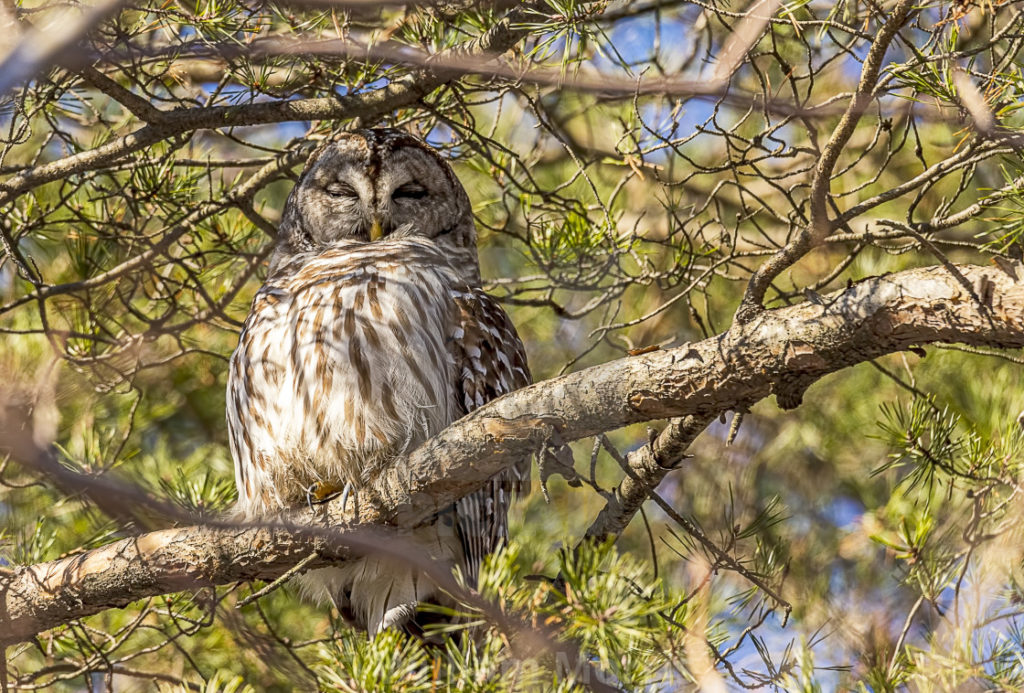ANIMAL: Barred Owl Strix varia Type of Animal: Owl Habitat: Closed & open forests/woodland, swampland, suburban areas, streamsides, upland areas & prefer being near water Location(s): E. half of continental U.S from SE Nebraska, E Kansas, Oklahoma, & E Texas onwards as well as extreme NW California, W & NE Oregon, N Idaho, parts of Washington & far W Montana. Also found in Canada in Maritime provinces, S Quebec, S Ontario, much of S Manitoba, S part of C Saskatchewan, W & C Alberta, E British Columbia (including S Vancouver Island) & extreme border area of British Columbia, Yukon & NW Territories. Another population in central W Mexico. Appearance: Large stocky owl w/ round head, no ear tufts, medium rounded tail, mottled brown & white, underbelly has vertical brown bars on white background, wings/tail barred brown & white, dark eyes, yellow talons Food/Diet: Mice, rats, tree & ground squirrels, chipmunks, flying squirrels, voles, rabbits, hares, shrews, moles, bats, weasels, mink, otters, domestic/feral cats, chickens, ducks, grouse, quail, woodpeckers, songbirds, jays, crows, pheasants, other owl species up to size of long-eared owls, doves, pigeons, amphibians, fish, opossums, lizards, snakes, young alligators, crayfish, crabs, turtles, slugs, scorpions, earthworms, beetles, grasshoppers, crickets, armadillos, spiders, snails, goat kids, centipedes Status in Wild: Stable Conservation: Not applicable Lifestyle: Solitary or monogamous pairs Additional Info: Called: Male-Cock Female-Hen Young-Owlet Group-Pair Weight: Male-1.38 lbs Female-1.76 lbs Gestation: 1 month Life Span: 15 years in wild, up to 30 years in captivity Height: Male-1.57 ft Female-1.67 ft Body Length: Male-1.57 ft Female-1.67 ft Tail Length: Male-8.5 in Female-10 in Main predators of adults are alligators, bears, coyotes, wolves, great horned owls, & northern goshawks. Other hawks & large owls prey on young, along w/ foxes, lynx, bobcat, cats, raccoons, & weasels. They have a 3.5 ft long wingspan, w/ females having slightly longer wingspan. Mostly nocturnal, though sometimes hunts during the day. They sometimes use nests used by other animals, such as those of hawks, crows, squirrels, & ravens. Sometimes hybridize w/ close relative, the Spotted Owl, in the west. Owlets stay w/ parents for 6 months. Fun Fact(s): It can make several sounds, such as hoots, monkey like whoops, & the characteristic “who cooks for you, who cooks for you all” hoot bark. Owlets will screech & shriek. Breeding pairs very defensive during nesting season, sometimes attacking people.


We had a barred owl nest in a dead tree on our wooded land last year. I don’t see it nesting there this year. Question: do they return to their previous nesting ground like some birds do? Or could they be nesting within in the same area and I just don’t see them?
They usually do return to their previous nesting grounds though it’s possible it found another part of the area to nest in